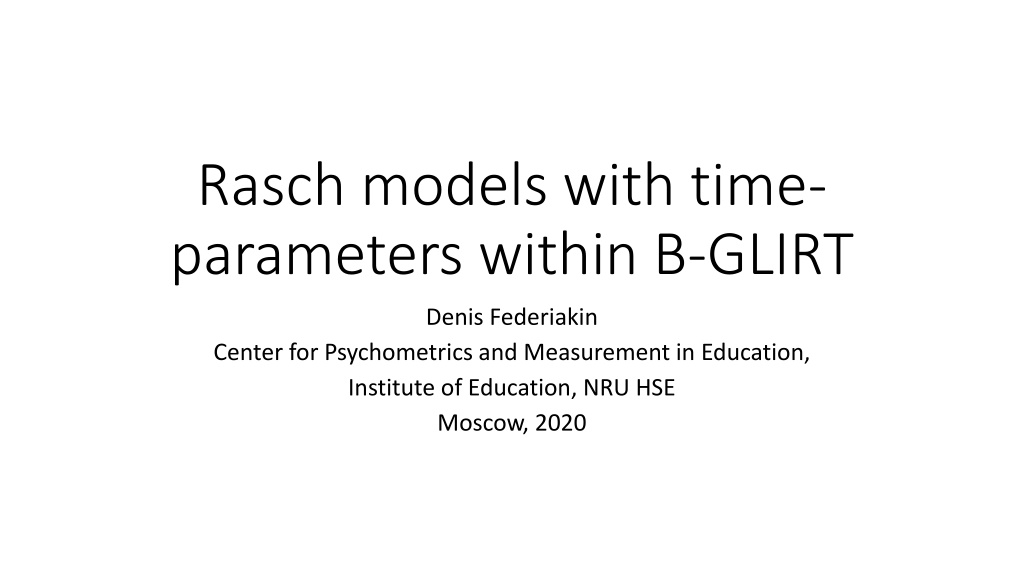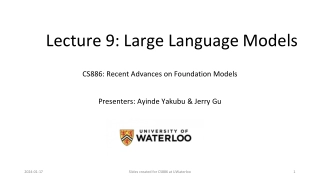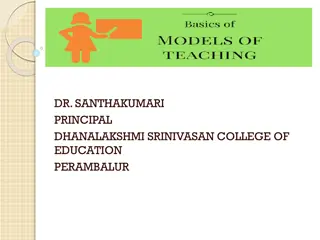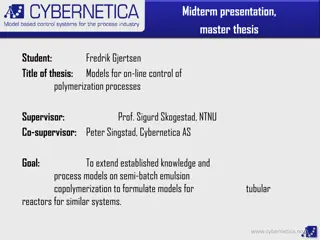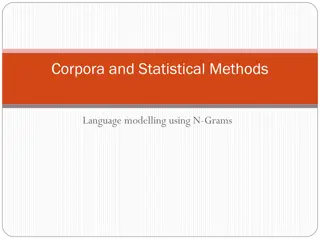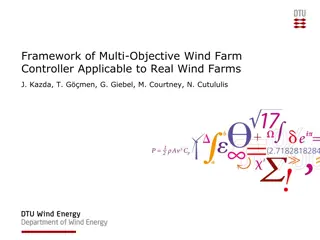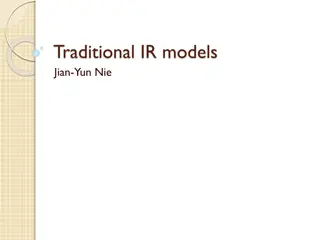Rasch Models within B-GLIRT Framework
This study delves into Rasch models within the B-GLIRT framework and explores simplistic Rasch models providing detailed item-level parameter information. The research includes discussions, simulation studies on parameter recovery, and an example of an Educational Evaluation test for higher education students.
Download Presentation

Please find below an Image/Link to download the presentation.
The content on the website is provided AS IS for your information and personal use only. It may not be sold, licensed, or shared on other websites without obtaining consent from the author.If you encounter any issues during the download, it is possible that the publisher has removed the file from their server.
You are allowed to download the files provided on this website for personal or commercial use, subject to the condition that they are used lawfully. All files are the property of their respective owners.
The content on the website is provided AS IS for your information and personal use only. It may not be sold, licensed, or shared on other websites without obtaining consent from the author.
E N D
Presentation Transcript
Rasch models with time- parameters within B-GLIRT Denis Federiakin Center for Psychometrics and Measurement in Education, Institute of Education, NRU HSE Moscow, 2020
Conceptual framework for item response time and item response accuracy (van der Linden, 2007) Population of persons (? ,? ) Domain of items (? ,? ) Level 2: Person ( ?) Person ( ?) Item ( ?) Item ( ?, ?) Level 1: ??? ??? Data:
Bivariate generalized linear IRT framework (B- GLIRT) (Molenaar, Tuerlinckx, van der Maas, 2015a) ? ? ??? = ? ?+ ? ? ln??? = ?+ ? ?+ ? ?; ? ? ? ?; ? 1 ? 1 ? ?1 ?? 1 ?1 ?? ?1 ?? 1 ? 1 ?
Cross-relation function ? ; Cross-relation function can have many forms (including non-linear) and describes the exact form of relations between seediness and ability Manipulating cross-relation function, it is possible to show that many IRT-models for response time and response accuracy can be described as special cases of the framework (e.g., van der Linden (2007), Fox, et al. (2007), Partchev & De Boeck (2012), De Boeck & Partchev (2012), Roskam (1987), Wang and Hanson (2005)) Nonetheless, is one of the key parameters according to the framework of van der Linden (2007) it describes correlation between speediness and ability: ? ; = ?
Speediness- and ability-tests Between-person speed-accuracy trade off suggests that the more time is spent on decision-making, the more accurate the decision is (traditional ability-tests) (Goldhammer, 2015) Nonetheless, some tests contain many simple items, and a respondent should solve them as quickly as possible (speediness-tests) (e.g., Cheung, & Yang, 2020) Since ? ; is the same for all items, it reflects an assumption that all items are either speediness-kind or ability-kind Moreover, it provides rather limited information on item-level time-parameters Unconstrained simplistic factor analytical model has not been studied yet under B-GLIRT formulation (Molenaar, Tuerlinckx, van der Maas, 2015b)
Current study This study aims to (i) investigate Rasch-models possible within B- GLIRT framework, and (ii) investigate a subset of simplistic Rasch- models which provide extended information on item-level parameters The outline: Discussion of the Rasch models within B-GLIRT framework Simulation study of the parameter recovery An example of EE test for higher education students
Rasch models within B-GLIRT framework ? ? ??? = ?+ ? ? ln??? = ?+ ? ?+ ? ?; ? Key point: ?provides more information on item-level (Fox, et all., 2007) by sacrificing information on test-level (no ) Originally proposed forms of ? ?; : Linear and polynomial function of ability ( ? Linear and polynomial function of interaction between ability and speediness ( ? Bolsinova, Molenaar, 2018) Polynomial function of difference between person ability and item intercept ( ? ?+ ? Their combinations, other functions (e.g., Ranger and Kuhn, 2012) and their fixed counterparts (Roskam, 1987) In Rasch-modelling the third form of ? ?; ? is not a simple option Therefore, further we discuss only the first two forms of ? ?; ? ?) ? ? ?) (see ?)
Design of the simulation study 1 Constants: ? = 20, all dichotomous ? = 2000 ? ?; ? = ? ? ? = ? = equally spaced vector of length ? from -2 to 2 Conditions = 0,0.25,0.5 100 replications for each condition: 2~???????(min = 0.16,max = 0.49) 2~???????(min = 0.16,max = 0.49) , ~???(?,?), where ? = 0,0 ,? = The proposed model: ? ? ??? ? ln??? = ?+ ? ?+ ? ? = ?+ ? 1 1 Statistics used for the analysis of simulations: ? ? ? ?=1 ???? = 2 ? ? ? ?=1 ???? = ? ? ? ?=1 ??? = Linear Pearson correlation
Results of the simulation study 1 = ? = ?.?? = ?.? Statistics Item difficulty vs. true values ( ?) Bias = 0.003 RMSE = 0.067 MAD = 0.053 Bias < 0.001 RMSE = 0.065 MAD = 0.051 Bias = 0.002 RMSE = 0.063 MAD = 0.050 Loading of ability on response times vs. true values ( ?) Loading of speediness on response times vs. true values ( ?) Ability estimates vs. true values ( ?) RMSE = 0.023 MAD = 0.017 RMSE = 0.163 MAD = 0.158 RMSE = 0.324 MAD = 0.317 RMSE = 0.018 MAD = 0.014 RMSE = 0.028 MAD = 0.023 RMSE = 0.087 MAD = 0.082 Cor = 0.940 (SD = 0.012) Cor = 0.940 (SD = 0.011) Cor = 0.947 (SD = 0.009) Speediness estimates vs. true values ( ?) Cor = 0.960 (SD = 0.015) Cor = 0.930 (SD = 0.012) Cor = 0.847 (SD = 0.015) RMSEA 0.003 (SD = 0.003) 0.003 (SD = 0.003) 0.004 (SD = 0.003)
Reliability Omega coefficient for correlated measurement errors (Bentler, 1972, 2009) is calculated on linear CFA model. Expected a Posteriori (EAP; Bock, Mislevy, 1982) and Warm s Weighted Maximum Likelihood (WLE; Warm, 1989) estimates were calculated on IRT model. = ? = ?.?? = ?.? Conditions Reliability Without time EAP 0.769 (0.007) 0.769 (0.007) 0.771 (0.007) WLE 0.753 (0.006) 0.753 (0.007) 0.755 (0.007) Omega for Ability 0.754 (0.007) 0.754 (0.008) 0.756 (0.008) With time Omega for Ability 0.961 (0.005) 0.974 (0.003) 0.981 (0.002) Omega for Speediness 0.969 (0.006) 0.967 (0.007) 0.957 (0.009)
Design of the simulation study 2 Constants: ? = 20, all dichotomous ? = 2000 ? ?; ? = ? ? ? = ? = equally spaced vector of length ? from -2 to 2 = 0.25 Conditions: ?( ?< 0) = (5,10) 100 replications for each condition: 2~???????(min = 0.16,max = 0.49) , ~???(?,?), where ? = 0,0 ,? = The studied model (see Fox, et al., 2007): ? ? ??? ? ln??? = ?+ ? ?+ ? ? = ?+ ? Constrained models (e.g., van der Linden, 2007): 1 1 ? ? ??? ? ln??? = ?+ ? ? ? ? = ? ?+ ? Statistics used for the analysis of simulations: ? ? ? ?=1 ???? = 2 ? ? ? ?=1 ???? = ? ? ? ?=1 ??? = Linear Pearson correlation
Results of the simulation study 2 ?( ?< 0) = 5 Bias < 0.001 RMSE = 0.065 MAD = 0.052 ?( ?< 0) = 10 Bias = 0.003 RMSE = 0.062 MAD = 0.049 Statistics Item difficulty vs. true values ( ?) Loading of ability on response times vs. true values ( ?) Loading of speediness on response times vs. true values ( ?) Ability estimates vs. true values ( ?) RMSE = 0.161 MAD = 0.156 RMSE = 0.164 MAD = 0.160 RMSE = 0.026 MAD = 0.022 RMSE = 0.026 MAD = 0.022 Cor = 0.987 (SD = 0.006) Cor = 0.959 (SD = 0.006) Speediness estimates vs. true values ( ?) Cor = 0.960 (SD = 0.007) Cor = 0.930 (SD = 0.012) RMSEA 0.003 (SD = 0.003) 0.003 (SD = 0.003)
Electrical Engineering test for higher education students 25 dichotomous items, 853 Russian and 1662 Chinese EE students For the following circuit: VCC =15V, the saturation voltage of both T1 and T2 is |UCES|=1V, the maximal output voltage amplitude of integrated operational amplifier is 13V, the threshold voltage of the diode is 0.7V. In the figure, the output Y is supposed to be Y = AB+ ? ?. The gates G1 and G2 must be, respectively Please determine the maximal output power of the circuit assuming that the amplitude of the input voltage is great enough. A. 15.6w B. 18.5w C. 10.6w D. 8.1w A. NOR, OR B. OR, NAND C. NAND, OR D. AND, NAND
EE Results 1 ? ? ??? = ?+ ? 2+ 3? ? 3 ? ln??? = ?+ ? ?+ 1? ?+ 2? ?
EE Results 2 ? ? ??? = ?+ ? 2+ 3? ? 3+ 4? ? ?+ 5? ? 2 ? ? ln??? = ?+ ? ?+ 1? ?+ 2? ? 2 ?) 2) 3) Interaction 1 ( ? ?) Interaction 2 ( ? -0.314 -0.129 -0.236 -0.137 -0.367 -0.378 -0.286 -0.191 0 0 -0.167 -0.194 0 0 -0.236 -0.36 -0.227 0 0 -0.202 -0.175 -0.114 0 0 0 Ability ( ?) 0.55 0.725 1.533 1.044 0.606 0.702 0.601 0.904 0.461 0.668 1.068 1.245 1.261 0.918 0.328 0.561 0.631 0.656 0.61 0.462 0.715 0.651 0.527 0.272 1.03 Ability 2 ( ? -0.079 -0.245 0 -0.19 -0.112 -0.163 -0.201 -0.201 -0.243 -0.215 -0.179 -0.158 -0.232 -0.222 -0.208 -0.166 -0.155 -0.284 -0.11 -0.202 -0.202 -0.244 -0.306 -0.179 -0.224 Ability 3 ( ? -0.054 0 -0.228 -0.153 -0.059 0 -0.034 -0.087 0 0 -0.131 -0.182 -0.199 -0.146 -0.044 -0.044 0 0 -0.078 0 -0.046 -0.034 0 0 -0.15 Item T1 T2 T3 T4 T5 T6 T7 T8 T9 T10 T11 T12 T13 T14 T15 T16 T17 T18 T19 T20 T21 T22 T23 T24 T25 Index The model without interactions The model with interactions 0 0 0 0 0 AIC 169360.578 168662.308 -0.123 -0.063 -0.150 0 0 0 0 0 0 0.058 0 -0.052 0 0 0 -0.070 0 0 0 0 BIC 170386.663 169979.894
Conclusion A set of simplistic Rasch models for item response accuracy and item response time can be proposed within B-GLIRT framework, but it limits possible cross-relation functions Distribution of single cross-relation function over the set of item- specific functions results in sufficient model fit and provides more insight on response process on item-level However, such models can be inefficient for measuring speediness parameter Increasing correlation of ability and speediness results in increased loading of item response time on ability, but barely affects other estimates
